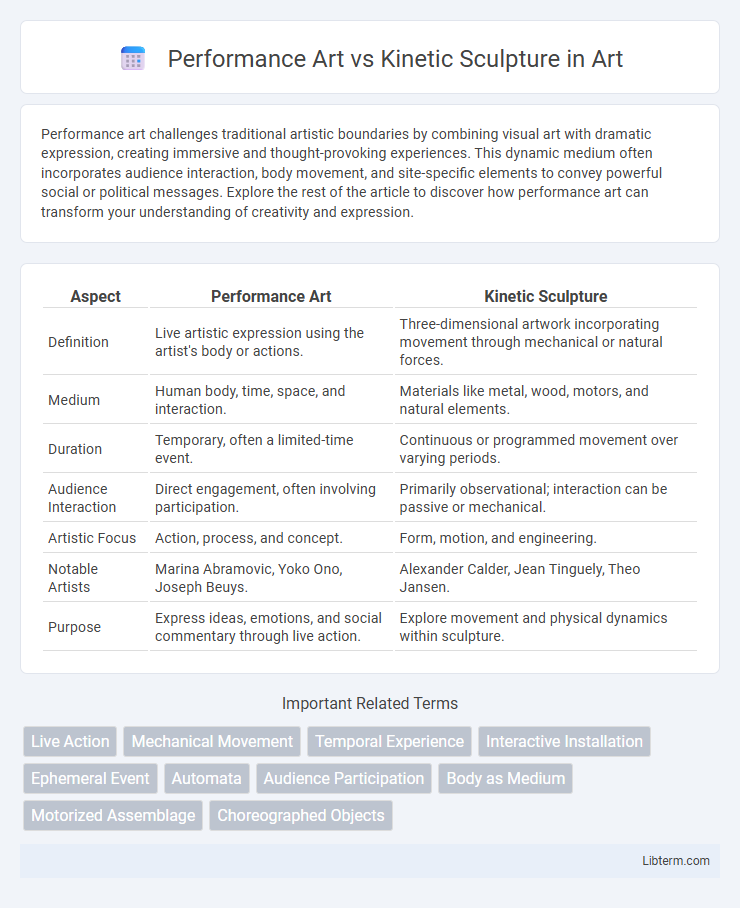Performance art challenges traditional artistic boundaries by combining visual art with dramatic expression, creating immersive and thought-provoking experiences. This dynamic medium often incorporates audience interaction, body movement, and site-specific elements to convey powerful social or political messages. Explore the rest of the article to discover how performance art can transform your understanding of creativity and expression.
Table of Comparison
| Aspect | Performance Art | Kinetic Sculpture |
|---|---|---|
| Definition | Live artistic expression using the artist's body or actions. | Three-dimensional artwork incorporating movement through mechanical or natural forces. |
| Medium | Human body, time, space, and interaction. | Materials like metal, wood, motors, and natural elements. |
| Duration | Temporary, often a limited-time event. | Continuous or programmed movement over varying periods. |
| Audience Interaction | Direct engagement, often involving participation. | Primarily observational; interaction can be passive or mechanical. |
| Artistic Focus | Action, process, and concept. | Form, motion, and engineering. |
| Notable Artists | Marina Abramovic, Yoko Ono, Joseph Beuys. | Alexander Calder, Jean Tinguely, Theo Jansen. |
| Purpose | Express ideas, emotions, and social commentary through live action. | Explore movement and physical dynamics within sculpture. |
Understanding Performance Art: Definition and Origins
Performance art is a live artistic expression that integrates time, space, and the artist's body, often challenging traditional boundaries of art by involving audience interaction and ephemeral experiences. Originating in the early 20th century with influences from Dada, Futurism, and Fluxus movements, it emphasizes spontaneity and conceptual themes rather than physical permanence. Unlike kinetic sculpture, which focuses on mechanical movement and physical form, performance art prioritizes transient actions and the relationship between performer and observer.
Defining Kinetic Sculpture: A Brief Overview
Kinetic sculpture is an art form that incorporates movement as a fundamental aspect of its design, often powered by motors, wind, or human interaction. Unlike static sculptures, kinetic sculptures engage viewers through dynamic motion, creating an evolving visual experience. This genre bridges engineering and art, emphasizing mechanical complexity alongside aesthetic expression.
Historical Evolution: Performance Art vs Kinetic Sculpture
Performance art emerged prominently in the 1960s as a dynamic response to traditional art forms, emphasizing the artist's body and live actions as primary mediums. Kinetic sculpture, evolving earlier in the 20th century with pioneers like Alexander Calder, integrates mechanical movement and engineering principles to create interactive, moving artworks. Both art forms reflect a shift toward experiential and participatory art, though performance art centers on temporal human presence, while kinetic sculpture focuses on the physical motion of objects.
Key Artists and Influential Works
Performance art pioneers like Marina Abramovic and Chris Burden use live actions to explore human experience, pushing boundaries of time and interaction. Kinetic sculpture artists such as Alexander Calder and Jean Tinguely create dynamic works integrating movement and mechanical elements, transforming static forms into interactive visual experiences. Key influential works include Abramovic's "The Artist Is Present," Burden's "Shoot," Calder's mobiles, and Tinguely's self-destructing sculptures, each redefining the relationship between art, audience, and motion.
Materials and Mediums Used
Performance art primarily employs the human body as its core medium, often augmented with props, costumes, and multimedia elements like video and sound to create ephemeral, live experiences. Kinetic sculpture centers on physical materials such as metal, wood, and plastic, incorporating mechanical or electronic components to facilitate movement within the artwork. While performance art focuses on temporality and human interaction, kinetic sculpture emphasizes engineered motion and the tangible manipulation of materials.
Audience Interaction and Engagement
Performance art emphasizes live interaction and evokes emotional responses through direct audience participation, creating a shared experience that evolves in real time. Kinetic sculpture engages viewers primarily through movement and visual stimuli, inviting observation and contemplation without requiring active involvement. Both art forms rely on dynamic elements but differ in how they foster audience connection, with performance art prioritizing immersive engagement and kinetic sculpture focusing on sensory and aesthetic interaction.
Movement and Temporality: Contrasting Approaches
Performance art emphasizes ephemeral movement and temporality through live human action, creating unique, time-bound experiences that often involve audience interaction and bodily presence. Kinetic sculpture incorporates mechanical or natural motion within physical objects, producing ongoing or repeatable movements that explore spatial dynamics and materiality over time. While performance art prioritizes transient, situational expression, kinetic sculpture focuses on sustained, observable movement embedded within static forms.
Space and Environment: Site-Specific Considerations
Performance art transforms space through temporal human interaction, emphasizing site-specific engagement where the environment directly influences the artistic expression and audience perception. Kinetic sculpture integrates mechanical movement within a defined physical context, often requiring spatial considerations like wind, light, and viewer positioning to activate and enhance the artwork's dynamic presence. Both art forms demand careful analysis of environmental factors to ensure the site enhances the conceptual and sensory impact, creating a cohesive relationship between object, space, and observer.
Conceptual Intentions and Artistic Goals
Performance art emphasizes temporal experiences and human presence, aiming to engage audiences through live actions that challenge social norms and provoke emotional or intellectual responses. Kinetic sculpture focuses on physical movement and mechanical interaction, exploring the relationship between form, motion, and space to create dynamic visual experiences. Both art forms interrogate traditional boundaries, but performance art centers on conceptual expression and immediacy, while kinetic sculpture prioritizes mechanized aesthetics and the transformation of static objects.
Future Trends in Performance Art and Kinetic Sculpture
Future trends in performance art emphasize immersive technologies, integrating virtual and augmented reality to create multisensory experiences that blur the line between audience and performer. Kinetic sculpture is increasingly incorporating smart materials and AI-driven mechanics, allowing dynamic, responsive artworks that evolve in real time. Both fields are converging towards interactive, technology-driven expressions, transforming traditional boundaries and expanding possibilities for artistic engagement.
Performance Art Infographic

 libterm.com
libterm.com